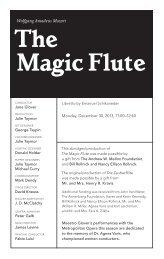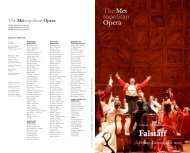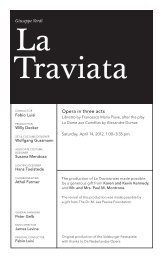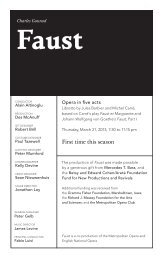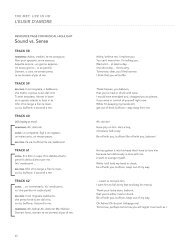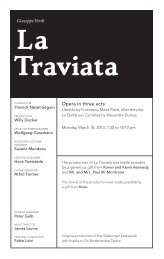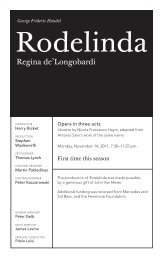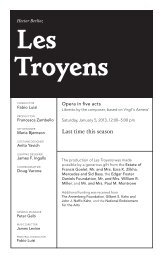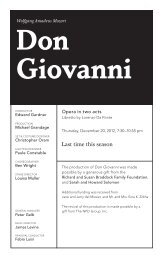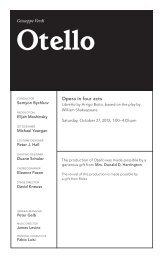Parsifal - Metropolitan Opera
Parsifal - Metropolitan Opera
Parsifal - Metropolitan Opera
Create successful ePaper yourself
Turn your PDF publications into a flip-book with our unique Google optimized e-Paper software.
Richard Wagner<br />
<strong>Parsifal</strong><br />
CONDUCTOR<br />
Asher Fisch<br />
PRODUCTION<br />
François Girard<br />
SET DESIGNER<br />
Michael Levine<br />
COSTUME DESIGNER<br />
Thibault<br />
Vancraenenbroeck<br />
LIGHTING DESIGNER<br />
David Finn<br />
VIDEO DESIGNER<br />
Peter Flaherty<br />
CHOREOGRAPHER<br />
Carolyn Choa<br />
DRAMATURG<br />
Serge Lamothe<br />
Stage consecrating festival play<br />
in three acts<br />
Libretto by the composer<br />
Friday, March 8, 2013, 6:00–11:35 pm<br />
New Production<br />
Last time this season<br />
The production of <strong>Parsifal</strong> was made possible<br />
by a generous gift from the Gramma Fisher<br />
Foundation, Marshalltown, Iowa<br />
Major funding for this production was<br />
received from Rolex<br />
Additional funding for this production was<br />
received from Marina Kellen French, and<br />
the Edgar Foster Daniels Foundation<br />
GENERAL MANAGER<br />
Peter Gelb<br />
MUSIC DIRECTOR<br />
James Levine<br />
PRINCIPAL CONDUCTOR<br />
Fabio Luisi<br />
A co-production of the <strong>Metropolitan</strong> <strong>Opera</strong>,<br />
the Opéra National de Lyon, and the<br />
Canadian <strong>Opera</strong> Company
2012–13 Season<br />
The 295th <strong>Metropolitan</strong> <strong>Opera</strong> performance of<br />
Richard Wagner’s<br />
<strong>Parsifal</strong><br />
Conductor<br />
Asher Fisch<br />
IN ORDER OF VOCAL APPEARANCE<br />
Gurnemanz<br />
René Pape<br />
Second Knight of the Grail<br />
Ryan Speedo Green*<br />
Second Sentry<br />
Lauren McNeese<br />
First Sentry<br />
Jennifer Forni<br />
First Knight of the Grail<br />
Mark Schowalter<br />
Kundry<br />
Katarina Dalayman<br />
Amfortas<br />
Peter Mattei<br />
Third Sentry<br />
Andrew Stenson*<br />
Fourth Sentry<br />
Mario Chang*<br />
<strong>Parsifal</strong><br />
Jonas Kaufmann<br />
Titurel<br />
Rúni Brattaberg<br />
A Voice<br />
Maria Zifchak<br />
Klingsor<br />
Evgeny Nikitin<br />
Flower Maidens<br />
Kiera Duffy<br />
Lei Xu*<br />
Irene Roberts<br />
Haeran Hong<br />
Katherine Whyte<br />
Heather Johnson<br />
Friday, March 8, 2013, 6:00–11:35 pm
Ken Howard/<strong>Metropolitan</strong> <strong>Opera</strong><br />
Jonas Kaufmann<br />
(center) as <strong>Parsifal</strong> in<br />
a scene from Act II of<br />
Wagner’s <strong>Parsifal</strong><br />
* Member of the<br />
Lindemann Young Artist<br />
Development Program<br />
Yamaha is the official piano<br />
of the <strong>Metropolitan</strong> <strong>Opera</strong>.<br />
Latecomers will not be<br />
admitted during the<br />
performance.<br />
Visit metopera.org<br />
Chorus Master Donald Palumbo<br />
Assistant Choreographer Anita Griffin<br />
Consultant for Wigs and Makeup Karine Guillem<br />
Assistants to the Costume Designer Marie La Rocca and<br />
Nathalie Pallandre<br />
Video<br />
Video Post Production Supervisor Pablo Colapinto<br />
Director of Photography Patrick Jones<br />
Video Line Producer Sarah Platt<br />
Musical Preparation Linda Hall, John Keenan,<br />
Carrie-Ann Matheson, Jonathan Kelly, and Patrick Furrer<br />
Assistant Stage Directors Laurie Feldman, Sandrine Lanno,<br />
Gina Lapinski, and Paula Williams<br />
Stage Band Conductor Gregory Buchalter<br />
Prompter Carrie-Ann Matheson<br />
German Coach Irene Spiegelman<br />
Children’s Chorus Director Anthony Piccolo<br />
Scenery, properties, and electrical props constructed<br />
and painted in Opéra National de Lyon Shops (France)<br />
and <strong>Metropolitan</strong> <strong>Opera</strong> Shops<br />
Costumes executed by Opéra National de Lyon Shops<br />
(France) and <strong>Metropolitan</strong> <strong>Opera</strong> Costume Shop<br />
Wigs executed by <strong>Metropolitan</strong> <strong>Opera</strong> Wig Department<br />
This performance is made possible in part by public funds<br />
from the New York State Council on the Arts.<br />
Before the performance begins, please switch off<br />
cell phones and other electronic devices.<br />
Met Titles<br />
To activate, press the red button to the right of the screen in front of your<br />
seat and follow the instructions provided. To turn off the display, press<br />
the red button once again. If you have questions please ask an usher at<br />
intermission.
Synopsis<br />
Act I Monsalvat, sanctuary of the Holy Grail<br />
Act II Klingsor’s magic castle and garden<br />
Act III Monsalvat, sanctuary of the Holy Grail<br />
PERFORMED WITH TWO INTERMISSIONS OF APPROXIMATELY 40 MINUTES EACH<br />
Act I<br />
Near the sanctuary of the Holy Grail, the old knight Gurnemanz and two sentries<br />
awake and perform their morning prayers, while other knights prepare a bath for<br />
their ailing ruler Amfortas, who suffers from an incurable wound. Suddenly Kundry<br />
appears, a mysterious, ageless woman, who serves as the Grail’s messenger.<br />
She has brought medicine for Amfortas. The king is carried in. He reflects on a<br />
prophecy that speaks of his salvation by the hands of a “pure fool, enlightened by<br />
compassion,” then is borne off. When the esquires ask about Klingsor, a sorcerer<br />
who is trying to destroy the knights of the Grail, Gurnemanz tells the story of<br />
Amfortas’s wound: the Holy Grail, the cup Christ drank from at the Last Supper,<br />
and the Spear that pierced his body on the cross were given into the care of<br />
Titurel, Amfortas’s father, who assembled a company of knights to guard the relics.<br />
Klingsor, wishing to join the brotherhood, tried to overcome his sinful thoughts by<br />
castrating himself but was rejected. Seeking vengeance, he built a castle across<br />
the mountains with a magic garden full of alluring women to entrap the knights.<br />
Amfortas set out to defeat Klingsor, but was himself seduced by a “terribly beautiful<br />
woman” and stabbed by Klingsor with the Holy Spear, which he then took from<br />
Amfortas. The wound can only be healed by the innocent youth the prophecy has<br />
spoken of. Suddenly a swan plunges to the ground, struck dead by an arrow. The<br />
knights drag in a young man, who boasts of his archery skills. He is ashamed when<br />
Gurnemanz rebukes him, but he cannot explain his violent act or even state his<br />
name. All he remembers is his mother, Herzeleide, or “Heart’s Sorrow.” Kundry<br />
tells the youth’s history: his father died in battle and his mother reared the boy<br />
in a forest, but now she too is dead. Gurnemanz leads the nameless youth to the<br />
banquet of the Grail, wondering if he may be the prophecy’s fulfillment.<br />
The knights assemble in the hall of the sanctuary. Titurel bids Amfortas uncover<br />
the Grail to give strength to the brotherhood, but Amfortas refuses: the sight of<br />
the chalice increases his anguish. Titurel orders the esquires to proceed, and the<br />
chalice casts its glow about the hall. The nameless youth watches in astonishment<br />
but understands nothing. The ceremony ended, Gurnemanz, disappointed and<br />
angry, drives him away as an unseen voice reiterates the prophecy.<br />
Visit metopera.org<br />
31
Synopsis CONTINUED<br />
Act II<br />
Klingsor, the necromancer, summons Kundry, who, under his spell, is forced to<br />
lead a double existence, to seduce the young fool. Having secured the Spear,<br />
Klingsor now seeks to destroy the youth, whom he knows can save the knights of<br />
the Grail. Hoping for redemption from her torment, Kundry protests in vain.<br />
The nameless youth enters Klingsor’s magic garden. Flower maidens beg for<br />
his love but he resists them. The girls withdraw as Kundry, transformed into<br />
a beautiful young woman, appears and addresses him by his name—<strong>Parsifal</strong>.<br />
He realizes that his mother once called him so in a dream. Kundry begins her<br />
seduction by revealing memories of <strong>Parsifal</strong>’s childhood and finally kisses him.<br />
<strong>Parsifal</strong> suddenly feels Amfortas’s pain and understands compassion: he realizes<br />
that it was Kundry who brought about Amfortas’s downfall and that it is his<br />
mission to save the brotherhood of the Grail. Astonished at his transformation,<br />
Kundry tries to arouse <strong>Parsifal</strong>’s pity: she tells him of the curse that condemns<br />
her to lead an unending life of constantly alternating rebirths ever since she<br />
laughed at Christ on the cross. But <strong>Parsifal</strong> resists her. She curses him to wander<br />
hopelessly in search of Amfortas and the Grail and calls on Klingsor for help. The<br />
magician appears and hurls the Holy Spear at <strong>Parsifal</strong>, who miraculously catches<br />
it, causing Klingsor’s realm to perish.<br />
32<br />
Act III<br />
Gurnemanz, now very old and living as a hermit near the Grail’s sanctuary, finds<br />
the penitent Kundry in the forest and awakes her from a deathlike sleep. An<br />
unknown knight approaches and Gurnemanz soon recognizes <strong>Parsifal</strong> bearing<br />
the Holy Spear. <strong>Parsifal</strong> describes his years of wandering, trying to find his way<br />
back to Amfortas and the Grail. Gurnemanz tells him that he has come at the<br />
right time: Amfortas, longing for death, has refused to uncover the Grail, the<br />
brotherhood is suffering, and Titurel has died, “a mortal like all of us.” Kundry<br />
washes <strong>Parsifal</strong>’s feet, and Gurnemanz blesses him and proclaims him king.<br />
As his first task <strong>Parsifal</strong> baptizes Kundry. He is struck by the beauty of nature<br />
around them and Gurnemanz explains that this is the spell of Good Friday. The<br />
distant tolling of bells announces the funeral of Titurel, and the three make their<br />
way to the sanctuary.<br />
Knights carry the Grail, Amfortas on his litter, and Titurel’s coffin into the Hall of the<br />
Grail. Amfortas is unable to perform the rite. He begs the knights to kill him and<br />
thus end his anguish—when suddenly <strong>Parsifal</strong> appears. He touches Amfortas’s<br />
side with the Spear and heals the wound. Uncovering the Grail, he accepts the<br />
homage of the knights as their redeemer and king and blesses them. The reunion<br />
of the Grail and Spear has enlightened and rejuvenated the community.
In Focus<br />
Richard Wagner<br />
<strong>Parsifal</strong><br />
Premiere: Bayreuth Festival House, 1882<br />
Wagner’s final opera is a musical journey unlike any other. The composer preferred to<br />
call his mature works “music dramas” to distinguish them from “conventional” opera,<br />
but he set <strong>Parsifal</strong> even further apart by naming it a Bühnenweihfestspiel, a “festival<br />
play for the consecration of a stage.” The stage in question was that of the Bayreuth<br />
Festival House, which Wagner had built to produce the Ring cycle, and the remarkable<br />
acoustic qualities of that theater informed much of the unique tone of <strong>Parsifal</strong>. The<br />
opera tells the tale of a young man who, despite—or perhaps because of—his extreme<br />
naiveté about the ways of the world is destined to renew a brotherhood of knights<br />
charged with guarding the relics of Christ’s last days—the Holy Grail, the chalice used at<br />
the Last Supper, and the Spear that wounded Christ. The loss of the Spear has sapped<br />
the brotherhood of its strength and made their country a wasteland. In his quest,<br />
<strong>Parsifal</strong> is both aided and opposed by Kundry, an enigmatic woman struggling under<br />
an ancient curse. The psychological, mythical, and mystical possibilities of such a story<br />
are obvious, and Wagner’s accomplishment results in an air of reverence that surrounds<br />
this piece. The solemnity of large parts of the score and its great length and musical<br />
demands also contribute to the notion of this as a unique work in the repertoire.<br />
The Creator<br />
Richard Wagner (1813–83) was the complex, controversial creator of music-drama<br />
masterpieces that stand at the center of today’s operatic repertory. Born in Leipzig,<br />
Germany, he was an artistic revolutionary who reimagined every supposition about<br />
music and theater. Wagner insisted that words and music were equals in his works.<br />
This approach led to the idea of the Gesamtkunstwerk, or “total work of art,”<br />
combining music, poetry, architecture, painting, and other disciplines, a notion that<br />
has had an impact on creative fields far beyond opera.<br />
The Setting<br />
<strong>Parsifal</strong> takes place in and around the sanctuary of the knights of the Holy Grail, at<br />
the mythical location of Monsalvat in Spain, during the Middle Ages. This new Met<br />
production places the action in an unspecified, timeless setting.<br />
The Music<br />
The score of <strong>Parsifal</strong> is an extraordinary blend of musical transcendence and dramatic<br />
cohesion. The use of bells and offstage choruses are among the unusual effects that<br />
create an almost liturgical atmosphere. The magnificent and expansive prelude<br />
conveys the important role the orchestra will play in creating a world in which time<br />
Visit metopera.org<br />
33
A scene from Don Carlo<br />
The <strong>Metropolitan</strong> <strong>Opera</strong> is pleased<br />
to salute Manhattan Jaguar in<br />
recognition of its generous support<br />
during the 2012–13 season.
In Focus CONTINUED<br />
itself is experienced in an unusual way. The vocal parts call for superior breath control<br />
to sustain the long melodic lines. Many passages demand a high degree of sheer<br />
lyrical beauty, most notably Gurnemanz’s narration in Act III, which accompanies the<br />
rapturous orchestral music known as the Good Friday Spell, and <strong>Parsifal</strong>’s final solo<br />
at the end of the opera. There are also jarringly dramatic moments, such as Kundry’s<br />
shrieks and groans of agony and her chilling vocal drop of almost two octaves in<br />
Act II when she confesses how she laughed at the crucifixion. The use of the chorus<br />
is equally remarkable: in the first Grail scene in Act I, a muscular, hymn-like melody<br />
seamlessly evolves into a succession of arching phrases beginning in the lowest<br />
voices (basses on stage) and rising to the highest (boy sopranos, invisible above the<br />
stage)—a musical bridge from earth to heaven. The scene of the Flower Maidens<br />
in the second act includes passages that depict the allure of attractive women with<br />
the traditional exoticisms of 19th-century Romantic opera. Conversely, passages in<br />
the second Grail scene (Act III) are striking early explorations of atonality. While the<br />
score of <strong>Parsifal</strong> contains endless opportunities for musicological study, perhaps its<br />
most notable feature is its approachability—there is nothing in it that requires the<br />
talents of a musicologist for full appreciation. As Wagner’s wife Cosima commented<br />
on this impression, “It’s all so direct!””<br />
<strong>Parsifal</strong> at the Met<br />
The first staged performance of <strong>Parsifal</strong> outside the Bayreuth Festival took place at the<br />
Met on Christmas Eve, 1903. The Wagner family had tried to keep the work exclusive<br />
to Bayreuth, but its German copyright had no force in the U.S. Alfred Hertz conducted<br />
a cast led by fellow Bayreuth veterans Alois Burgstaller, Milka Ternina, and Anton van<br />
Rooy. The designs were inspired by the Bayreuth original, and Scientific American<br />
published an article outlining the technical upgrades done on the Met stage to<br />
prepare for this then cutting-edge presentation. The Met toured <strong>Parsifal</strong> extensively<br />
during the 1904–05 season, giving much of the country its first full experience of<br />
the work. German operas were not performed at the Met during the First World<br />
War, but <strong>Parsifal</strong> returned when Artur Bodanzky conducted a new production in<br />
1920, designed by Joseph Urban and sung in English (German was restored in 1922).<br />
Between 1926 and 1948, Lauritz Melchoir was the dominating presence in the title<br />
role, with other artists of the era including Frida Leider, Kirsten Flagstad, and Astrid<br />
Varnay (Kundry), Friedrich Schorr and Herbert Janssen (Amfortas), and Michael<br />
Bohnen, Emanuel List, and Alexander Kipnis (Gurnemanz). Fritz Stiedry conducted a<br />
new production by Leo Kerz in 1956, and 1970 saw another new staging by Nathaniel<br />
Merrill, with Leopold Ludwig on the podium. The most recent production, directed<br />
by Otto Schenk and designed by Günther Schneider-Siemssen, premiered in 1991<br />
with James Levine conducting Plácido Domingo, Jessye Norman, Robert Lloyd, and<br />
Franz Mazura. François Girard’s new production opened on February 15, 2013, with<br />
Jonas Kaufmann, Katarina Dalayman, Peter Mattei, Evgeny Nikitin, and René Pape<br />
in the leading roles and Daniele Gatti conducting.<br />
Visit metopera.org<br />
Ins1
Program Note<br />
When he finished orchestrating Götterdämmerung on November 21,<br />
1874, Richard Wagner added a brief but emphatic postscript to the<br />
score’s last page: “I will say no more!” He had a good deal more<br />
to say with his art, though—never mind how much the fading ebb of D-flat<br />
major that ends the Ring may sound like closure. Inevitably Wagner was drawn<br />
back to a project he had begun to brood over even before embarking on the<br />
Ring. He first encountered the early-13th-century chivalric romance by Wolfram<br />
von Eschenbach that provided his chief source for <strong>Parsifal</strong> in the remarkably<br />
productive summer of 1845, in the spa town of Marienbad, while on vacation<br />
from his duties as a conductor for Dresden’s opera house. With his confidence<br />
boosted by the recent completion of Tannhäuser—Wagner had feared he<br />
would die before finishing it—he sketched out plans for Lohengrin and<br />
Die Meistersinger von Nürnberg and also made his earliest contact with the<br />
characters who would appear in his swan song for the stage.<br />
Wagner was an ambitious and determined man of 32 that summer; by the time<br />
he began writing the music for <strong>Parsifal</strong>, he had reached his mid-60s, a weathered<br />
and withdrawn composer suffering from angina. He completed the full score in<br />
January 1882, just a little more than a year before his death in Venice. <strong>Parsifal</strong>’s<br />
gestation thus exceeded that of the Ring. Such patience over the long game<br />
allowed Wagner to return to the subject periodically as new associations emerged.<br />
In a letter in which he notes that “Parzival is again coming very much to life in me,”<br />
Wagner compares the increasing clarity with which the still-to-be-written opera<br />
takes shape to the process of ripening and acknowledges that many years “may<br />
yet have to pass” before that state is achieved. (The composer later settled on the<br />
spelling “<strong>Parsifal</strong>,” his idiosyncratic variant on the medieval sources.)<br />
In 1865, responding to a request from King Ludwig II, his patron, Wagner<br />
produced a detailed sketch—including elaboration of the backstory pertaining<br />
to the Grail itself and the origin of the order of knights assigned to protect<br />
it—which closely anticipates the synopsis of <strong>Parsifal</strong> as we know it. But with his<br />
attention taken up by projects already underway, most notably the remainder<br />
of the Ring, Wagner continued to let this ripen. He needed barely more than<br />
a month to write the libretto itself when <strong>Parsifal</strong> at last became his central<br />
preoccupation in January 1877, following the first-ever staging of the Ring cycle<br />
the previous summer. During the three intervening decades, Wagner’s thinking<br />
about the <strong>Parsifal</strong> story had absorbed the dramatic changes in his worldview,<br />
from the materialist revolutionary convinced the world could be improved to<br />
the adherent of Arthur Schopenhauer’s philosophy of the life force as blind<br />
illusion that must be overcome by renunciation, which in turn encouraged the<br />
composer’s interest in Buddhism.<br />
For several reasons, though, despite the coexistence of so many layers,<br />
<strong>Parsifal</strong> has a reputation for being a single-mindedly Christian work. The<br />
composer’s champion-turned-foe Friedrich Nietzsche set the tone for this<br />
Ins2
eading by portraying Wagner as “fallen sobbing at the foot of the Cross.”<br />
The solemnity with which <strong>Parsifal</strong> was originally introduced only enhanced the<br />
impression of performances as a quasi-liturgy accompanied by sacred music. Yet<br />
Jesus is never actually referred to directly, and Wagner uses Christian imagery<br />
and symbols much as he had incorporated those of pagan myth and legend in<br />
the Ring. As Wagner wrote in his late essay Art and Religion, art is able to reveal<br />
the “deep and hidden truth” of the “mythic symbols” which religion “would<br />
have us believe in their literal sense.” François Girard, director of the new Met<br />
production, observes that “Wagner was trying to reconcile all the aspects of<br />
his spirituality” in this final period of his life. “He wanted to turn them into one<br />
gesture that would sum up his idea of the ‘total work of art.’”<br />
There are many parallels between Wagner’s treatment of myth and legend in<br />
the Ring librettos and in <strong>Parsifal</strong>. In both cases he concocted a unified narrative<br />
of his own invention by isolating what he wanted from the episodic sprawl he<br />
found in his primary sources and from recent scholarly glosses on them. In fact,<br />
Wagner disdainfully complained that Wolfram’s poem “blunders about” from<br />
one adventure to another and that the author “understands nothing whatever of<br />
the real content.” It was the composer’s decision to align <strong>Parsifal</strong>’s quest for the<br />
Grail with the medieval Christian legends defining the Holy Grail as the chalice<br />
that collected the blood shed by Jesus during the Crucifixion. The pre-Christian<br />
Celtic sources of the Parzival epic are reflected in Wolfram’s depiction of the Grail<br />
as a supernatural gemstone. Wagner actually interpreted the “Nibelung hoard,”<br />
which in material terms symbolizes the power conferred by Alberich’s ring, as<br />
another pagan version of the Christianized Holy Grail; in <strong>Parsifal</strong>, meanwhile, the<br />
Grail’s life-sustaining efficacy is reminiscent of Freia’s golden apples.<br />
At the same time, Wagner applied what he had learned dramaturgically<br />
from Tristan und Isolde to his representation of <strong>Parsifal</strong>’s epic quest. (His<br />
interest in the Grail knight had been reawakened while composing the former<br />
by the parallel he sensed between Tristan and Amfortas—both trapped by<br />
desire—and Wagner even contemplated introducing a cameo appearance by<br />
the wandering <strong>Parsifal</strong> in the earlier work’s last act as Tristan lies dying.) <strong>Parsifal</strong>,<br />
like Tristan, abstracts the onstage action into a few potently concentrated and<br />
highly resonant encounters. These reveal the “real content” of the quest to be<br />
an interior journey toward enlightenment. The entire opera is structured by an<br />
overarching symmetry of lucid simplicity: <strong>Parsifal</strong>’s incomprehension when he<br />
first observes the Grail ceremony presided over by the suffering Amfortas and<br />
his act of healing in the final scene form the two great pillars that are connected<br />
by the hero’s intervening trial.<br />
Wagner not only selected what he considered the essential threads within<br />
Wolfram’s epic but also fused traits taken from a variety of its characters—and<br />
from other sources—to create the enigmatic figure of Kundry. Her contradictions<br />
make her the most complex personality in <strong>Parsifal</strong> and arguably in all of Wagner.<br />
Visit metopera.org<br />
Ins3
Program Note CONTINUED<br />
Kundry, who provides the link between the crumbling realm of Monsalvat and<br />
the external world, serves as the agent of <strong>Parsifal</strong>’s enlightenment at the very<br />
moment she attempts to destroy him. The English scholar Lucy Beckett observes<br />
that aspects of Kundry also derive from other works Wagner had planned but<br />
abandoned along the way: his sketches for the play Jesus of Nazareth (1848),<br />
with its premise that art could “recover” the lost essence of Christianity, and for<br />
Die Sieger (“The Victors,” 1856), a music drama Wagner envisioned that would<br />
draw on a Buddhist story of the renunciation of desire.<br />
On account of its prolonged genesis—and of course its status as the<br />
composer’s farewell to the stage—<strong>Parsifal</strong> is often approached as a work of<br />
summation, of backward glances. On one level it does after all reprise the central<br />
characters and themes of Wagner’s life work. Along with the parallel between<br />
Amfortas and Tristan already mentioned, <strong>Parsifal</strong> bursts on the scene like the<br />
guileless, naive Siegfried, a child of nature, while Klingsor burns with a desire<br />
for revenge as intense as Alberich’s. Kundry time-travels across generations,<br />
a female Flying Dutchman cursed for her blasphemy. These echo effects are<br />
even more apparent in the relationships between the characters: <strong>Parsifal</strong><br />
resisting Kundry has a precursor in Venus’s attempt to ensnare Tannhäuser,<br />
and Gurnemanz, despite his impatience, recalls something of the wise Hans<br />
Sachs in the hope he invests in the young newcomer.<br />
Wagner, moreover, wove personal experiences from across the span of his<br />
life into the fabric of <strong>Parsifal</strong>’s music, imagery, and scenic conception, such as<br />
the “Dresden Amen” from the city where he once harbored revolutionary hopes<br />
or the tolling bells he heard in his exile in Zurich. In particular, when Wagner<br />
witnessed a hen’s helpless suffering as it was slaughtered in a shop one day,<br />
it triggered an epiphany that would prove to be the key to the opera he was<br />
still years away from writing. Perceiving the suffering that lies at the heart of<br />
existence—symbolized by Amfortas’s wound—is what awakens compassion<br />
(Mitleid) within <strong>Parsifal</strong> and opens the way toward redemption.<br />
But if <strong>Parsifal</strong> at times suggests another variation on familiar Wagnerian<br />
themes and characters, it also stands apart. As director Girard remarks, here<br />
Wagner “reaches even beyond” his earlier grand syntheses to create “an<br />
elusive piece that speaks to the heart and the soul through channels that we’re<br />
not used to dealing with.”<br />
Wagner even invented a special generic term, Bühnenweihfestspiel, for the<br />
opera, a pretentious-sounding compound that really just refers to its status as a<br />
work to inaugurate the stage of the Bayreuth Festival. Technically the Ring had<br />
already done that in 1876. But seeing the cycle performed had been depressingly<br />
anti-climactic, the palest shadow of what his imagination had carried all those<br />
years. In contrast, he created <strong>Parsifal</strong> with a clear sense of the distinctive sonority<br />
and immersive experience of the Bayreuth space: a space designed to maximize<br />
the audience’s identification with the dreamlike realm represented onstage.<br />
Visit metopera.org<br />
Ins5
Program Note CONTINUED<br />
<strong>Parsifal</strong>’s sound world reverberates with colors, nuances, and textures unlike<br />
anything else found in Wagner. In the notes to his 1970 recording, Pierre Boulez<br />
remarked that this music “places the emphasis for the first time on uncertainty,<br />
on indetermination” and shows “an aversion to definitiveness in musical phrases<br />
as long as they have not exhausted their potential for evolution and renewal.”<br />
Wagner’s widow Cosima tried to intensify <strong>Parsifal</strong>’s mystique—more cynical<br />
observers would call it a marketing ploy—by restricting staged performances<br />
to Bayreuth for the 30-year duration of its copyright. At the time, however, the<br />
United States was not party to international copyright law. Incurring Cosima’s<br />
wrath and causing a scandal, the Met stirred up enormous excitement by staging<br />
the first American performance on Christmas Eve in 1903, to front-page coverage.<br />
The desire to control <strong>Parsifal</strong> of course also applies to the ultimate meanings<br />
of this lucid yet most elusive of Wagner’s creations. Some argue that it encodes<br />
the toxic brew of Wagner’s late-period racist ravings, with Amfortas’s wound as<br />
a proto-Nazi symbol of contamination by “inferior” races. Others are profoundly<br />
disturbed by what they perceive as deep misogyny or even a blasphemous<br />
mimicry of Christianity. <strong>Parsifal</strong>’s rich production history only underscores<br />
the extraordinary ambivalence that makes the work so endlessly fascinating.<br />
Nietzsche himself, who remains among the harshest of the work’s critics, reminds<br />
us that <strong>Parsifal</strong> can generate contradictory responses even within the same<br />
person. Having damned the opera as “a curse on the senses and the spirit,” after<br />
hearing the Prelude performed he wrote of its “penetration of vision that cuts<br />
through the soul as with a knife.”<br />
—Thomas May<br />
Ins6
The Cast and Creative Team<br />
Asher Fisch<br />
conductor (jerusalem, israel)<br />
this season <strong>Parsifal</strong> at the Met, Fidelio and Wagner’s Ring cycle with the Seattle <strong>Opera</strong>,<br />
Die Zauberflöte and Der Fliegende Holländer in Munich, and Manon Lescaut in Hamburg.<br />
met appearances The Magic Flute, Madama Butterfly, The Merry Widow (debut, 2000), and<br />
Rigoletto.<br />
career highlights He is currently Principal Guest Conductor of the Seattle <strong>Opera</strong> and was<br />
formerly Music Director of the New Israeli <strong>Opera</strong> and Vienna Volksoper. In September 2013<br />
he becomes Principal Conductor and Artistic Advisor of the West Australian Symphony<br />
Orchestra. Highlights of recent seasons include Don Carlo, Tosca, Turandot, and Die<br />
Zauberflöte in Munich, Rigoletto at the Dresden State <strong>Opera</strong>, The Merry Widow with the<br />
Paris <strong>Opera</strong> and at La Scala, Cavalleria Rusticana and Pagliacci at the Vienna State <strong>Opera</strong>,<br />
and Turandot with the Seattle <strong>Opera</strong>.<br />
François Girard<br />
director (quebec, canada)<br />
this season <strong>Parsifal</strong> for his debut at the Met.<br />
career highlights His work in opera includes a double-bill of Weill and Brecht’s The<br />
Lindbergh Flight and The Seven Deadly Sins at the Lyon <strong>Opera</strong> and later at the Edinburgh<br />
Festival and in Wellington; <strong>Parsifal</strong> and Saariaho’s Émilie for the Lyon <strong>Opera</strong>; Siegfried<br />
and a double-bill of Stravinsky’s Oedipus Rex and Symphony of Psalms for the Canadian<br />
<strong>Opera</strong> Company; and the oratorio Lost Objects for Brooklyn Academy of Music’s Bang<br />
on a Can Festival. Films include the feature-length biopic Thirty-Two Short Films about<br />
Glenn Gould (1993), The Red Violin (1998, Academy Award for Best Original Score), and<br />
Silk (2007). He was writer and director of Cirque du Soleil’s Zarkana (New York, Madrid, and<br />
Moscow) and director of Zed, Cirque du Soleil’s permanent show in Tokyo.<br />
Visit metopera.org<br />
Ins7
The Cast and Creative Team CONTINUED<br />
Michael Levine<br />
set designer (toronto, canada)<br />
this season <strong>Parsifal</strong> at the Met.<br />
met productions Madama Butterfly (set designer), Eugene Onegin (set and costume<br />
designer; debut, 1997) and Mefistofele (set and costume designer).<br />
career highlights Among his opera credits are Das Rheingold for the Canadian <strong>Opera</strong><br />
company (director and designer); Capriccio, Rusalka, and Les Contes d’Hoffmann for<br />
the Paris <strong>Opera</strong>; Elektra in Florence; L’Incoronazione di Poppea at the Glyndebourne<br />
Festival and Vienna’s Theater an der Wien; Bernstein’s Candide at Paris’s Châtelet in<br />
a co-production with English National <strong>Opera</strong> and La Scala; Der Fliegende Holländer<br />
at Covent Garden; Alexander Raskatov’s A Dog’s Heart with English National <strong>Opera</strong>;<br />
Les Contes d’Hoffmann, Don Giovanni, and A Midsummer Night’s Dream at La Scala;<br />
and <strong>Parsifal</strong> and A Midsummer Night’s Dream in Lyon. His designs for theatre include<br />
A Disappearing Number, The Elephant Vanishes, and Mnemonic for Complicité, The<br />
Beautiful End in London’s West End, Tectonic Plates for Ex Machina, and Revengers<br />
Tragedy for the Royal Shakespeare Company.<br />
Thibault Vancraenenbroeck<br />
costume designer (brussels, belgium)<br />
this season <strong>Parsifal</strong> for his debut at the Met.<br />
career highlights His collaborations with director François Girard and the Lyon <strong>Opera</strong><br />
include <strong>Parsifal</strong>, Saariaho’s Émilie, and a double-bill of Weill and Brecht’s The Lindbergh<br />
Flight and The Seven Deadly Sins. Additional projects include Werther (Lyon) and L’Elisir<br />
d’Amore (Baden-Baden) with Rolando Villazón directing; and Jenůfa (Paris’s Théâtre du<br />
Châtelet), Die Zauberflöte (Lyon <strong>Opera</strong>), Wozzeck (Munich’s Bavarian State <strong>Opera</strong>), Don<br />
Carlo (La Scala), Wagner’s Ring cycle (Aix-en-Provence Festival and Salzburg Easter<br />
Festival), Pelléas et Mélisande (Paris’s Opéra Comique), and Idomeneo (Paris’s Théâtre<br />
des Champs-Élysées), all directed by Stéphane Braunschweig. In addition to opera, he<br />
also creates sets and costumes for dance and theater and has worked with Dominique<br />
Baguette, Barbara Manzetti, Olga de Soto, Pierre Droulers, Charlie Degotte, Sébastien<br />
Chollet, Nathalie Mauger, Yves Beaunesne, Sybille Cornet, Sofie Kokaj, Marc Liebens,<br />
Boris Charmatz, Françoise Berlanger, Cindy Van Acker, Alexis Moati, Anna van Brée,<br />
Andréa Novicov, Perrine Valli, and Maya Boesch.<br />
Visit metopera.org<br />
35
The Cast and Creative Team CONTINUED<br />
David Finn<br />
lighting designer (st. paul, minnesota)<br />
this season <strong>Parsifal</strong> for his debut at the Met, Romeo and Juliette for the Paris <strong>Opera</strong> Ballet<br />
and La Scala Ballet, Cirque du Soleil’s MJ 2013 in Las Vegas, and Arabella for Santa Fe<br />
<strong>Opera</strong> and Minnesota <strong>Opera</strong>.<br />
career highlights At the age of 16 he began working for puppeteer Burr Tillstrom and the<br />
famed Kukla, Fran and Ollie television show. He received the 2012 Knight of Illumination<br />
Award for Sweet Violets (Royal Ballet) and the 2011 Yomiuri Award for The Hunting Gun<br />
(Tokyo). He collaborated with François Girard on Cirque du Soleil’s permanent show, Zed,<br />
in Tokyo and has also designed for the Paris <strong>Opera</strong>, Covent Garden, Salzburg Festival, La<br />
Scala, Brussels’s La Monnaie, Lyon <strong>Opera</strong>, Stuttgart <strong>Opera</strong>, Canadian <strong>Opera</strong> Company, New<br />
York City <strong>Opera</strong>, Glimmerglass <strong>Opera</strong>, San Francisco <strong>Opera</strong>, Florence’s Teatro Comunale,<br />
and Vienna Festival. He has designed dance works for Twyla Tharp, Paul Taylor, Hanya<br />
Holm, Merce Cunningham, Sasha Waltz, José Limón, James Kudelka, Helgi Tomasson, and<br />
Dana Reitz, and was resident designer for Mikhail Baryshnikov’s White Oak Dance Project.<br />
Architectural projects include The Kramlich Residence in Napa Valley with the design firm<br />
of Herzog & de Meuron and film work includes The Age of Innocence directed by Martin<br />
Scorsese and The Green Monster (which Finn directed for PBS’s POV series in 1999).<br />
Peter Flaherty<br />
video designer (boston, massachusetts)<br />
this season <strong>Parsifal</strong> for his debut at the Met.<br />
career highlights His recent directing project, Soul Leaves Her Body, opened in New York<br />
in 2010 and began international touring last year. His award-winning short film, Signal<br />
from Shore, is currently playing in film festivals and his recent large-scale video installation,<br />
Pass Back a Revolver, had its premiere at Philadelphia’s Institute of Contemporary Art.<br />
He created video and projection design for Roundabout Theatre’s Broadway production<br />
of Sondheim on Sondheim, and frequent theatre collaborators include The Builders<br />
Association, Complicité, François Girard, James Lapine, Chen Shi-Zheng, Basil Twist,<br />
and Bang on a Can. His video art has been shown at MIT Media Lab, Fleisher-Ollman<br />
Gallery, and at the home of Agnes Gund (President Emerita of MoMA). He has received<br />
grants from the New York State Council on the Arts, Rockefeller MAP Fund, Doris Duke<br />
Foundation, and Jerome Foundation, among others. He is currently head of video for<br />
performance at CalArts and has also taught at the Yale School of Drama, Carnegie Mellon<br />
University, and New York University.<br />
36
Carolyn Choa<br />
choreographer (hong kong, china)<br />
this season <strong>Parsifal</strong> at the Met.<br />
met productions Madama Butterfly (associate director and choreographer, debut, 2005).<br />
career highlights Her choreography credits include “The Storyteller Series” and “The<br />
Greek Myths Series” (Jim Henson/Channel 4), The Bartered Bride (Belfast <strong>Opera</strong>), Eugene<br />
Onegin and Lakmé (Royal College of Music), The Land of Smiles (Royal Academy of Music),<br />
Moll Flanders (Granada Television), The English Patient (Miramax Films), The Talented<br />
Mr. Ripley (Paramount/Miramax), Feast of Snails (London’s West End), Danscross (Beijing<br />
Dance Academy), Kommilitonen! (Royal Academy of Music and Juilliard School of Music),<br />
and The Pilgrim’s Progress (English National <strong>Opera</strong>). She shared an Olivier Award with<br />
director Anthony Minghella for Madama Butterfly, produced the film The Wisdom of<br />
Crocodiles, and was co-editor and translator of the Vintage Book of Chinese Fiction.<br />
Serge Lamothe<br />
dramaturg (quebec, canada)<br />
this season <strong>Parsifal</strong> for his debut at the Met.<br />
career highlights Novelist, poet, and dramatist, he has worked with director François<br />
Girard on a number of projects including Cirque du Soleil’s Zed (Tokyo, 2008) and<br />
Zarkana (Radio City Music Hall, 2011); Lyon <strong>Opera</strong>’s The Lindbergh Flight and The<br />
Seven Deadly Sins (Brecht/Weil, 2006), Émilie (Saariaho, 2010), and <strong>Parsifal</strong> (2012). His<br />
theatrical adaptations include Kafka’s The Trial (Théâtre du Nouveau Monde, Montreal,<br />
2004), Yasushi Inoue’s The Hunting Gun (Usine C, Montreal, 2010; Parco Theater, Tokyo,<br />
2011—Kinokuniya and Yomiuri awards), and Yukio Mishima’s The Temple of the Golden<br />
Pavilion (directed by Amon Miyamoto, Kanagawa Arts Theater and Lincoln Center<br />
Festival, 2011). His original play, The Prince of Miguasha, was granted the Yves Thériault<br />
Award by Radio Canada in 2003, and his independent works include the books Les<br />
Enfants Lumière (2012), Les Urbanishads (2010), Metarevers (2009), Tarquimpol (2007),<br />
The Baldwins (2006), L’Ange au Berceau (2002).<br />
Visit metopera.org<br />
37
The Cast and Creative Team CONTINUED<br />
Katarina Dalayman<br />
soprano (stockholm, sweden)<br />
this season Kundry in <strong>Parsifal</strong> and Brünnhilde in Die Walküre, Siegfried, and Götterdämmerung<br />
at the Met and Brünnhilde at Munich’s Bavarian State <strong>Opera</strong>.<br />
met appearances Isolde and Brangäne (debut, 1999) in Tristan und Isolde, the Duchess of<br />
Parma in Busoni’s Doktor Faust, Sieglinde in Die Walküre, Lisa in The Queen of Spades,<br />
and Marie in Wozzeck.<br />
career highlights She has sung the title roles of Elektra and Carmen, Maddalena in<br />
Andrea Chénier, and Brünnhilde in Ring performances in Stockholm; Brünnhilde in<br />
Siegfried at the Aix-en-Provence Festival; Desdemona in Otello, Eva in Die Meistersinger<br />
von Nürnberg, Mimì in La Bohème, and Elisabeth in Tannhäuser in Stuttgart; Brünnhilde<br />
in Ring performances at the Vienna State <strong>Opera</strong>; Marie at Covent Garden and in<br />
Paris; Ariadne in Ariadne auf Naxos in Paris, Brussels, Dresden, and Munich; Tosca in<br />
Copenhagen and Berlin; Lisa with Lyric <strong>Opera</strong> of Chicago and in Munich; the Duchess<br />
of Parma at the Salzburg Festival; Judith in Bluebeard’s Castle at Covent Garden; and<br />
Kundry at Paris’s Bastille <strong>Opera</strong>.<br />
Jonas Kaufmann<br />
tenor (munich, germany)<br />
this season The title role of <strong>Parsifal</strong> at the Met and Vienna State <strong>Opera</strong>, the title role of Don<br />
Carlo at Covent Garden and the Salzburg Festival, Cavaradossi in Tosca and Manrico in<br />
Il Trovatore at Munich’s Bavarian State <strong>Opera</strong>, and the title role of Lohengrin at La Scala.<br />
met appearances The title role of Faust, Siegmund in Die Walküre, Cavaradossi, Don José<br />
in Carmen, Alfredo in La Traviata (debut, 2006), and Tamino in Die Zauberflöte.<br />
career highlights His first performances as Lohengrin in Munich in 2010 followed by his<br />
debut at the Bayreuth Festival in the same role. Recent performances include Bacchus in<br />
Ariadne auf Naxos as well as Don José and Rodolfo in La Bohème at the Salzburg Festival,<br />
Don Carlo in Munich and London, Faust in Vienna, and Maurizio in Adriana Lecouvreur<br />
at Covent Garden and in concert at the Deutsche Oper Berlin and Carnegie Hall. He<br />
has also sung Florestan in Fidelio in Munich and Paris, Werther in Vienna and Paris, Des<br />
Grieux in Manon in Chicago and Vienna, the Prince in Humperdinck’s Königskinder in<br />
Zurich, and Alfredo at the Paris <strong>Opera</strong> and La Scala.<br />
Visit metopera.org<br />
39
The Cast and Creative Team CONTINUED<br />
Peter Mattei<br />
baritone (piteå, sweden)<br />
this season Amfortas in <strong>Parsifal</strong> at the Met and the title role of Don Giovanni at the Vienna<br />
State <strong>Opera</strong> and in Zurich.<br />
met appearances Figaro in Il Barbiere di Siviglia, Don Giovanni, Marcello in La Bohème,<br />
Yeletsky in The Queen of Spades, Shishkov in From the House of the Dead, and Count<br />
Almaviva in Le Nozze di Figaro (debut, 2002).<br />
career highlights Recent performances include the title role of Billy Budd at the Frankfurt<br />
<strong>Opera</strong>, the title role of Eugene Onegin for his debut with the Vienna State <strong>Opera</strong>, and<br />
Don Giovanni at La Scala and the Paris <strong>Opera</strong>. He has also sung Don Giovanni at the<br />
Deutsche Staatsoper Berlin, Count Almaviva at Covent Garden and the San Francisco<br />
<strong>Opera</strong>, Eugene Onegin at the Salzburg Festival and Tanglewood Festival, Posa in Don<br />
Carlo with the Norwegian <strong>Opera</strong>, Wolfram in Tannhäuser at La Scala, and Guglielmo in<br />
Così fan tutte with the Royal Swedish <strong>Opera</strong>.<br />
Evgeny Nikitin<br />
bass-baritone (murmansk, russia)<br />
this season Klingsor in <strong>Parsifal</strong> at the Met, Rangoni in Boris Godunov in Madrid, Telramund<br />
in Lohengrin at Munich’s Bavarian State <strong>Opera</strong>, Amfortas in <strong>Parsifal</strong> in Zurich, and Gunther<br />
in Götterdämmerung at the Paris <strong>Opera</strong>.<br />
met appearances Rangoni, Orest in Elektra, Pogner in Die Meistersinger von Nürnberg,<br />
Colline in La Bohème, Fasolt in Das Rheingold, Creon/The Messenger in Oedipus Rex,<br />
and Dolokhov in War and Peace (debut, 2002).<br />
career highlights He has recently sung Tomsky in The Queen of Spades at the Paris<br />
<strong>Opera</strong>, the Dutchman in Der Fliegende Holländer in Tokyo, Mussorgsky’s Songs and<br />
Dances of Death in Berlin, the title role of Boris Godunov in Nice, Don Pizarro in Fidelio<br />
in Valencia, and Ibn-Hakia in Iolanta at the Salzburg Festival. He has also sung with Paris’s<br />
Châtelet (Boris Godunov and the title role of Rubinstein’s The Demon) and frequently at<br />
St. Petersburg’s Mariinsky Theatre (Boris Godunov, Prince Igor, Ruslan in Glinka’s Ruslan<br />
and Lyudmila, King Philip in Don Carlo, Amfortas, Wotan, Don Giovanni, and Figaro.<br />
40 Visit metopera.org
MetGiftCard<br />
The Perfect Gift for<br />
<strong>Opera</strong> Lovers!<br />
Met Gift Cards, in five elegant designs, are available<br />
at the box office, in the Met <strong>Opera</strong> Shop, and online.<br />
Cards may be redeemed for tickets, merchandise,<br />
Met memberships, and more.<br />
Learn more at metopera.org/giftcard
The Cast and Creative Team CONTINUED<br />
René Pape<br />
bass (dresden, germany)<br />
this season Gurnemanz in <strong>Parsifal</strong> at the Met, Wotan in Die Walküre at La Scala, King<br />
Marke in Tristan und Isolde and King Philip in Don Carlo with Munich’s Bavarian State<br />
<strong>Opera</strong>, and Wotan in Das Rheingold and Die Walküre, Sarastro in Die Zauberflöte, and<br />
King Philip with the Deutsche Staatsoper Berlin.<br />
met appearances Nearly 200 performances of 23 roles, including the title role of Boris<br />
Godunov, Méphistophélès in Faust, King Philip, King Marke, Sarastro and the Speaker<br />
(debut, 1995) in Die Zauberflöte, Pogner in Die Meistersinger von Nürnberg, Escamillo in<br />
Carmen, Banquo in Macbeth, King Henry in Lohengrin, Leporello in Don Giovanni, Orest<br />
in Elektra, Ramfis in Aida, and Rocco in Fidelio.<br />
career highlights He appears frequently at all the world’s leading opera houses, including<br />
La Scala, Covent Garden, the Paris <strong>Opera</strong>, Vienna State <strong>Opera</strong>, Munich’s Bavarian State<br />
<strong>Opera</strong>, and Lyric <strong>Opera</strong> of Chicago, as well as the festivals of Glyndebourne, Bayreuth, and<br />
Salzburg. He also appears regularly with the New York Philharmonic, Chicago Symphony<br />
Orchestra, Berlin Philharmonic, and Boston Symphony Orchestra, among others.<br />
42



